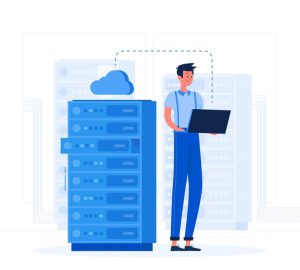MANAGED SERVICES
- Desktop Management
- Server Management
- Network Management
- Mail Management
- Security Management
- Storage Management
- Vendor Management
- IT Asset Management
- Configuring and overseeing IT Policy
Desktop Management

Desktops, laptops, and peripherals (printers, scanners) will all be covered in this. Hardware, operating systems, office automation, mail, moves, additions, and changes, viruses, patch management, and any other unique client needs will all be covered by the support.
Server Management

With the assistance of resources located on-site, our staff will remotely administer servers. Hardware troubleshooting, administration, patch management, OS hardening, server performance reports (memory utilization, disk IO, CPU utilization, network utilization), managing user groups and profiles in the active directory, and any other unique client requirements will all be covered by the services.
Network Management

The services will include network performance administration and monitoring for all active and passive components. identification, investigation, and troubleshooting; escalation when required; configuration management; quality of service; configuring new links; keeping track of all used and unused IP addresses; upgrading IOS; document changes; labeling and tagging for simple identification and troubleshooting; and any additional unique client requirements.
Mail Management

Management of user accounts mailbox creation, deletion, and transfer. When an authorized document is received, a new mail ID should be created for any additional groups or employees. keeping an eye on the mail traffic queue and mail disk space utilization, Establishing and Setting Up Mailing S/W Clients, backup with knowledge of Lotus Notes and Microsoft Exchange.
Security Management

Firewall, IPS, IDS, VPN, Endpoint security, Unified Threat Management, Identity and Access Management, Periodic Reporting, Alert configuration, and any other unique client needs are all covered by managed security services.
Storage Management

Coordinating tape and disk-based backups, adhering to backup policies, automating backups with software, performing full backups on a regular basis, off-site storage, and handling any additional unique client requirements.
Vendor Management

keeping track of a database of the different vendors’ information, including contact information, phone numbers, an escalation matrix, and commitments about response and resolution times, recording phone conversations with suppliers, collaborating with suppliers to address issues and provide solutions, collaborating with suppliers on IT-related advertisements, escalating issues as needed.
IT Asset Management

Keeping a database of all the IT assets, including computers, laptops, servers, printers, modems, scanners, switches, routers, and so on; documenting and keeping track of all the information pertaining to each IT asset, including its serial number, asset code, installation and expiration dates, departmental and hardware configuration details, Asset categorization and tagging must be completed for every IT asset. Documentation of new equipment, relocations, configuration modifications, etc.
Configuring and overseeing IT Policy

We provide customers with a standard IT policy document template as part of ISO policy, which they can modify in accordance with their needs in consultation with a customer representative. Together with our Manager, we conduct the contract-mandated periodic review at the customer’s location.
- Desktop Management
- Server Management
- Network Management
- Mail Management
- Security Management
- Storage Management
- Vendor Management
- IT Asset Management
- Configuring and overseeing IT Policy
Desktop Management

Desktops, laptops, and peripherals (printers, scanners) will all be covered in this. Hardware, operating systems, office automation, mail, moves, additions, and changes, viruses, patch management, and any other unique client needs will all be covered by the support.
Server Management

With the assistance of resources located on-site, our staff will remotely administer servers. Hardware troubleshooting, administration, patch management, OS hardening, server performance reports (memory utilization, disk IO, CPU utilization, network utilization), managing user groups and profiles in the active directory, and any other unique client requirements will all be covered by the services.
Network Management

The services will include network performance administration and monitoring for all active and passive components. identification, investigation, and troubleshooting; escalation when required; configuration management; quality of service; configuring new links; keeping track of all used and unused IP addresses; upgrading IOS; document changes; labeling and tagging for simple identification and troubleshooting; and any additional unique client requirements.
Mail Management

Management of user accounts mailbox creation, deletion, and transfer. When an authorized document is received, a new mail ID should be created for any additional groups or employees. keeping an eye on the mail traffic queue and mail disk space utilization, Establishing and Setting Up Mailing S/W Clients, backup with knowledge of Lotus Notes and Microsoft Exchange.
Security Management

Firewall, IPS, IDS, VPN, Endpoint security, Unified Threat Management, Identity and Access Management, Periodic Reporting, Alert configuration, and any other unique client needs are all covered by managed security services.
Storage Management

Coordinating tape and disk-based backups, adhering to backup policies, automating backups with software, performing full backups on a regular basis, off-site storage, and handling any additional unique client requirements.
Vendor Management

keeping track of a database of the different vendors’ information, including contact information, phone numbers, an escalation matrix, and commitments about response and resolution times, recording phone conversations with suppliers, collaborating with suppliers to address issues and provide solutions, collaborating with suppliers on IT-related advertisements, escalating issues as needed.
IT Asset Management

Keeping a database of all the IT assets, including computers, laptops, servers, printers, modems, scanners, switches, routers, and so on; documenting and keeping track of all the information pertaining to each IT asset, including its serial number, asset code, installation and expiration dates, departmental and hardware configuration details, Asset categorization and tagging must be completed for every IT asset. Documentation of new equipment, relocations, configuration modifications, etc.
Configuring and overseeing IT Policy

We provide customers with a standard IT policy document template as part of ISO policy, which they can modify in accordance with their needs in consultation with a customer representative. Together with our Manager, we conduct the contract-mandated periodic review at the customer’s location.
